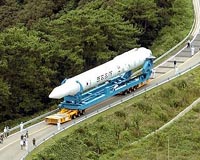 |
Seoul, South Korea (Yonhap) Aug 26, 2009 Naro Space Center aims to become the cradle of South Korea's aspirations to build up its nascent aerospace sector, the state-run think tank operating the facility said Tuesday. Located 485km south of Seoul, the sprawling complex covering 5.07 million square meters was built at a cost of 312.4 billion won (US$251.4 million), with construction beginning in January 2005, the Korea Aerospace Research Institute (KARI) said. The center is equipped with a state-of-the-art mission director center, flight safety control facilities and a launch pad. It has a meteorological observatory, radar and optical tracking systems to follow the trajectory of all rockets launched and houses a rocket assembly facility. Efforts are also underway to build an engine combustion test building to check the performance and safety of rockets to be built in the country. The lack of an engine combustion test facility has held up full-fledged development of locally made rockets with South Korea relying on foreign rockets and launch facilities to send its satellites into space in the past. From 1992, South Korea sent up 10 satellites all using foreign rockets and overseas launch pads. If the Korea Space Launch Vehicle-1 (KSLV-1) can successfully send the Science and Technology Satellite-2 into space, it will make South Korea the 13th country to join the "space club." The club is made up of countries that currently operate space centers and can send satellites into orbit using indigenous rockets. After the KSLV-1 program is completed next year with the blast off of a second rocket and satellite payload, Naro will build a launch pad capable of sending a larger rocket into space. "Development of the center will be directly linked to plans to build a fully indigenous space rocket and satellites independent of outside help," said a KARI spokesman. He pointed out that work on a locally made 30-ton liquid-fuel rocket is almost complete with only its actual fire test to remain. A more powerful rocket is also being developed. A fire test refers to a rocket being filled with fuel and oxidation agents and ignited to mimic an actual blast off on the ground. Seoul wants to launch an indigenous rocket called the KSLV-2 capable of carrying a satellite into space by 2018. Such a feat could make the country one of the top 10 space rocket technology leaders in the world, and reduce the technology gap that exists with leading space development countries like the United States and Russia. These countries started making rockets and satellites in the 1950s, while South Kores started making small. experimental rockets in the 1990s. Exact specifications for the KSLV-2 have yet to be drawn although designers said the next rocket may be 50 meters tall and have three stages with double the thrust of the KSLV-1. The size of the payload may reach 1.5 tons. For the long run, the country wants to send a probe to orbit the moon by 2020 and to build an unmanned lander that can touch down on the lunar surface five years later.
Source: Yonhap Share This Article With Planet Earth
Related Links Korea Aerospace Research Institute Launch Pad at Space-Travel.com
 South Korea's First Rocket Moved To Launch Pad
South Korea's First Rocket Moved To Launch PadSeoul, South Korea (Yonhap) Aug 24, 2009 South Korea's first space rocket has been moved to its launch pad from the assembly complex in preparation for the historic launch scheduled for this week, the state-run aerospace institute said Sunday. Korea Aerospace Research Institute (KARI), responsible for the launch, said the Korea Space Launch Vehicle-1 (KSLV-1), also called Naro-1, reached the launch pad earlier in the day with ... read more |
|
| The content herein, unless otherwise known to be public domain, are Copyright 1995-2009 - SpaceDaily. AFP and UPI Wire Stories are copyright Agence France-Presse and United Press International. ESA Portal Reports are copyright European Space Agency. All NASA sourced material is public domain. Additional copyrights may apply in whole or part to other bona fide parties. Advertising does not imply endorsement,agreement or approval of any opinions, statements or information provided by SpaceDaily on any Web page published or hosted by SpaceDaily. Privacy Statement |